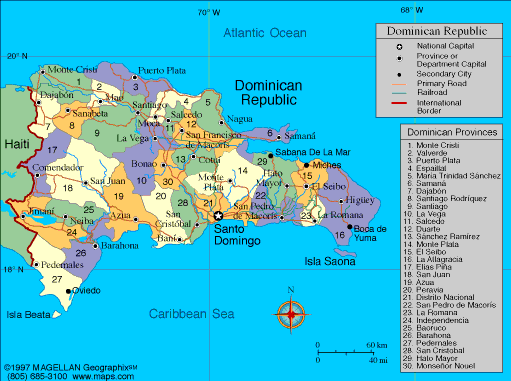DOMINICAN REPUBLIC

Geography: The Dominican Republic in the West Indies occupies the eastern two-thirds of the island of Hispaniola, which it shares with Haiti. Its area equals that of Vermont and New Hampshire combined. Duarte Peak, at 10,417 ft (3,175 m), is the highest point in the West Indies.
Government: Representative democracy.
History: The Dominican Republic was explored by Columbus on his first voyage in 1492. He named it La Española, and his son, Diego, was its first viceroy. The capital, Santo Domingo, founded in 1496, is the oldest European settlement in the Western Hemisphere.
Spain ceded the colony to France in 1795, and Haitian blacks under Toussaint L'Ouverture conquered it in 1801. In 1808, the people revolted and captured Santo Domingo the next year, setting up the first republic. Spain regained title to the colony in 1814. In 1821 Spanish rule was overthrown, but in 1822 the colony was reconquered by the Haitians. In 1844, the Haitians were thrown out and the Dominican Republic was established, headed by Pedro Santana. Uprisings and Haitian attacks led Santana to make the country a province of Spain from 1861 to 1865.
President Buenaventura Báez, faced with an economy in shambles, attempted to have the country annexed to the U.S. in 1870, but the U.S. Senate refused to ratify a treaty of annexation. Disorder continued until the dictatorship of Ulíses Heureaux; in 1916, when chaos broke out again, the U.S. sent in a contingent of marines, who remained until 1924.
A sergeant in the Dominican army trained by the marines, Rafaél Leonides Trujillo Molina, overthrew Horacio Vásquez in 1930 and established a dictatorship that lasted until his assassination in 1961, 31 years later. In 1962, Juan Bosch of the leftist Dominican Revolutionary Party, became the first democratically elected president in four decades.
Government: Representative democracy.
History: The Dominican Republic was explored by Columbus on his first voyage in 1492. He named it La Española, and his son, Diego, was its first viceroy. The capital, Santo Domingo, founded in 1496, is the oldest European settlement in the Western Hemisphere.
Spain ceded the colony to France in 1795, and Haitian blacks under Toussaint L'Ouverture conquered it in 1801. In 1808, the people revolted and captured Santo Domingo the next year, setting up the first republic. Spain regained title to the colony in 1814. In 1821 Spanish rule was overthrown, but in 1822 the colony was reconquered by the Haitians. In 1844, the Haitians were thrown out and the Dominican Republic was established, headed by Pedro Santana. Uprisings and Haitian attacks led Santana to make the country a province of Spain from 1861 to 1865.
President Buenaventura Báez, faced with an economy in shambles, attempted to have the country annexed to the U.S. in 1870, but the U.S. Senate refused to ratify a treaty of annexation. Disorder continued until the dictatorship of Ulíses Heureaux; in 1916, when chaos broke out again, the U.S. sent in a contingent of marines, who remained until 1924.
A sergeant in the Dominican army trained by the marines, Rafaél Leonides Trujillo Molina, overthrew Horacio Vásquez in 1930 and established a dictatorship that lasted until his assassination in 1961, 31 years later. In 1962, Juan Bosch of the leftist Dominican Revolutionary Party, became the first democratically elected president in four decades.

Map of
Dominican Republic
President: Danilo Medina (2012)
Land area: 18,680 sq mi (48,381 sq km);
total area: 18,815 sq mi (48,730 sq km)
Population (2014 est.): 10,349,741
(growth rate: 1.25%); birth rate: 18.97/1000; infant mortality rate:
19.63/1000; life expectancy: 77.8
Capital and largest city (2011 est.):
Santo Domingo, 2.191 million
Other large city: Santiago de los
Caballeros, 501,800
Monetary unit: Dominican Peso
National name: República
Dominicana
Language:
Spanish
Ethnicity/race:
mixed 73%, white 16%, black 11%
National Holiday:
Independence Day, February 27
Religion:
Roman Catholic 95%, other 5%
Literacy rate: 90.1% (2011 est.)
Economic summary: GDP/PPP (2013
est.): $101 billion; per capita $9,700. Real growth rate:
2%. Inflation: 5%. Unemployment: 15%. Arable
land: 16.44%. Agriculture: sugarcane, coffee, cotton, cocoa,
tobacco, rice, beans, potatoes, corn, bananas; cattle, pigs, dairy
products, beef, eggs. Labor force: 4.912 million (2013 est);
services 63.1%, industry 22.3%, agriculture 14.6% (1998
est.). Industries: tourism, sugar processing, ferronickel and
gold mining, textiles, cement, tobacco. Natural resources:
nickel, bauxite, gold, silver. Exports: $9.825 billion
(2013 est.): ferronickel, sugar, gold, silver, coffee, cocoa,
tobacco, meats, consumer goods. Imports: $16.8 billion
(2013 est.): foodstuffs, petroleum, cotton and fabrics,
chemicals and pharmaceuticals. Major trading partners: U.S.,
UK, Haiti, China, Venezuela, Colombia, Mexico (2012).
Communications: Telephones: main lines
in use: 1.065 million (2012); mobile cellular: 9.038 million (2012).
Broadcast media: combination of state-owned
and privately owned broadcast media; 1 state-owned TV network and a
number of private TV networks; networks operate repeaters to extend
signals throughout country; combination of state-owned and privately
owned radio stations with more than 300 radio stations operating (2007).
Internet
hosts: 404,500 (2012). Internet users: 2.701 million (2009).
Transportation: Railways: total: 142 km
(2008). Roadways: total: 19,705 km; (2002). Ports and harbors: Boca Chica, Puerto Plata,
Rio Haina, Santo Domingo. Airports: 36 (2013).
International disputes: Haitian
migrants cross the porous border into the Dominican Republic to find
work; illegal migrants from the Dominican Republic cross the Mona
Passage each year to Puerto Rico to find better work.
-------------------- o --------------------
No comments:
Post a Comment